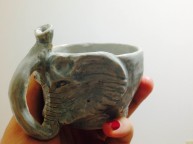My CIP that I was given an opportunity to involve myself in was as an assistant English teacher as Ohara Junior High school in Ohara, which is 45 minutes north east of the Imadegawa campus. I am currently on my final semester of college and plan to try and go into english teaching in Japan when I graduate, because of this I wanted my CIP to involve some kind of teaching English. Getting into contact with the school was done mainly by the KCJS staff and Senseis so I was very lucky with that and because of that I had a very smooth transition to participating weekly. It was mainly through email and I was by myself for the first half but was joined by Jordan afterwards. The travel was not very bad as there were buses directly to the school from kokusaikaikan and then buses from Ohara to Kyoto station so it was very easy to head there. The travel there was also very worth it as you get to experience the Japanese mountainside which is a amazing experience as the quiet town of Ohara was small beautiful town that had quiet a few temples and amazing landscapes to visit.
My overall experience with the program was amazing. This was a middle school and because of that they had grades 1 through grades 9 there. I was told that I was going to be help teach a different class year each visit from grades 3 to 9. I had to create a self introduction to use for every class, which I constantly updated every visit to try and make it simple and easy as possible since I knew some class’ English was still very simple. The hardest part was trying to figure out and adjust to to how I had to talk when teaching different classes. Some classes I could speak a bit more complex, such as with the 9th grades but with the younger classes I had to throw in Japanese and speak very slowly and simple. I was originally worried about teaching a different class each time as I would not be able to go past self introduction with classes and get more natural experience teaching English in Japan. This however was a non issue a few weeks in. Me and Jordan were invited to stay for 2nd English period, which was always the 9th graders so we started to see them everyday. Because of these I got to experience more natural lessons with Japanese students and how they learned english and because of that I could understand how to help talk with the students as I went to each new class. It was also very fun to get to know the students as some students started to open up more to us as we went each week and talked to us about just random hobbies before and after class.
Every week it was very fun to see how the new classes reacted to us and how each of them was always very excited to see us come and talk to them. This was always prevalent when I could find hobbies that I knew they also liked. Being able to connect with the students through stuff like games and anime was very exciting. They would always end up asking a lot of questions during class and after class to me that had to do with things they were interested in and how they were in America. They showed a lot of interest and it made it very fun and fulfilling for me.
The one unfortunate part is that you will not be using Japanese very often in this sort of CIP, as many of the teachers and students will always try and talk to you in English for their practice. There were a few times that I had to use Japanese for various reasons in and outside of class but they were few and far between. One of the main things that I got from this program was connections and future advice as I was able to talk to a American teacher that was also a English teacher there at the school. Almost every Japanese school apparently had assistant teachers and because of that you can make very important and close connections with your fellow English and non English teachers there.
Overall, If any future KCJS student has a passing interesting in teaching I would heavily recommend trying to find a CIP that lets you teach English. There are various options depending on how good you are with kids as well as options of private tutoring and public school settings. My opportunity was a very good window into Japanese English teaching for me in the future as I was able to get first hand experience while here and Japan as well as just experience the cultural difference that Japanese schools held. By the later part of the program I saw students before class during lunch and clean up time and they would always great me and ask questions to us, which always made me smile and happy I picked this CIP. Having the opportunity to teach as my CIP was a very great experience that I would recommend anyone else to do if they have interest or are able to, you will not regret it!

